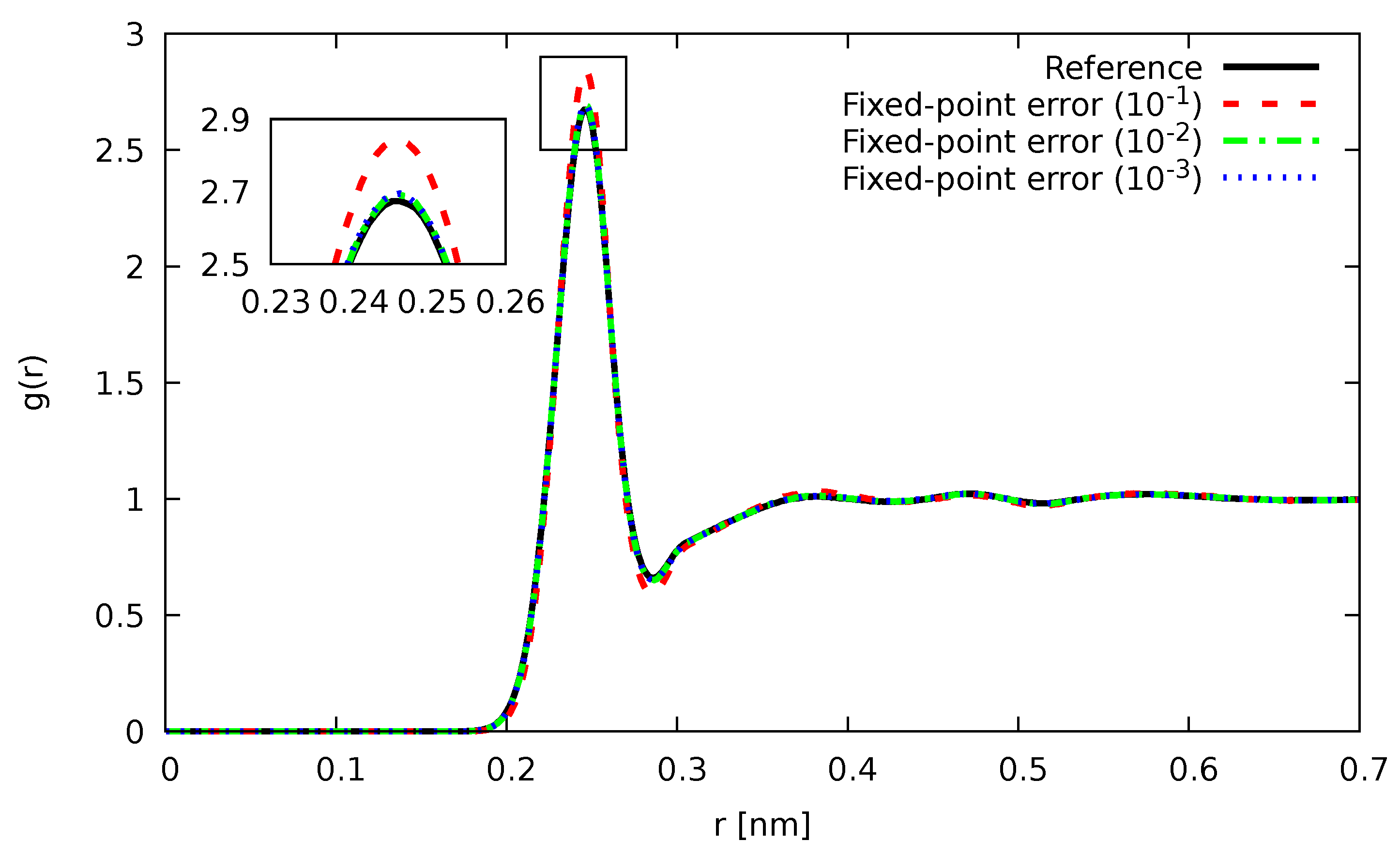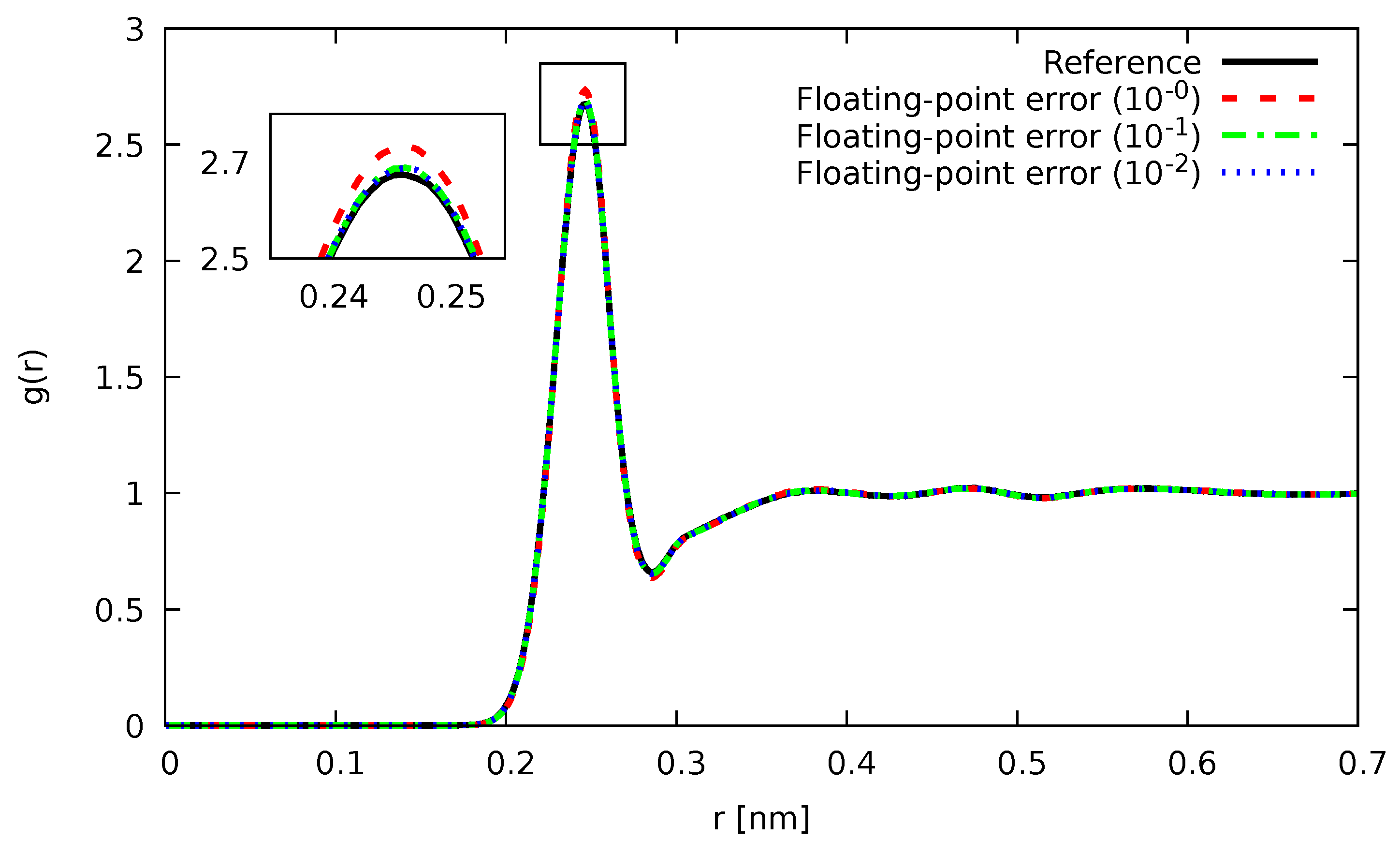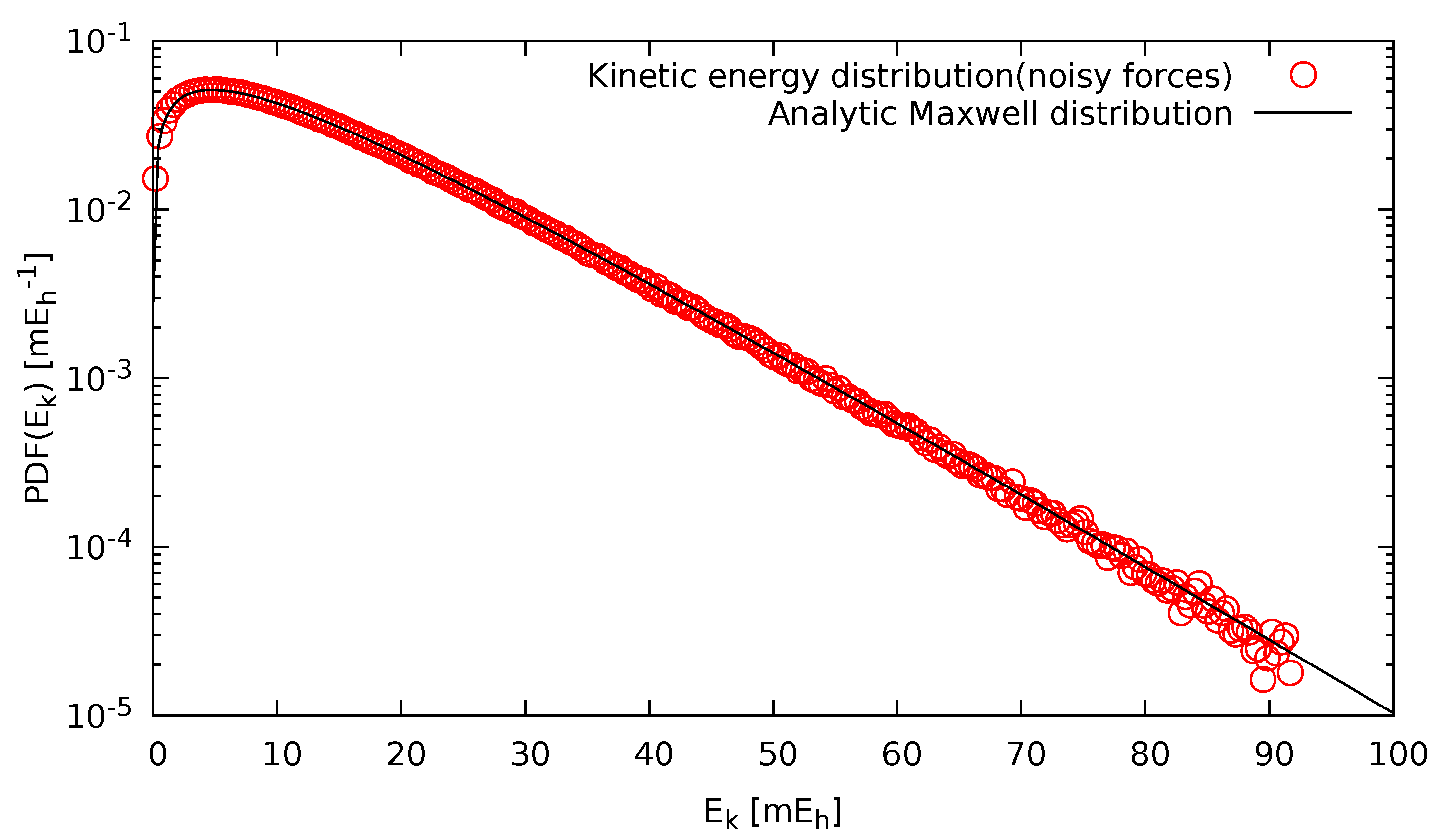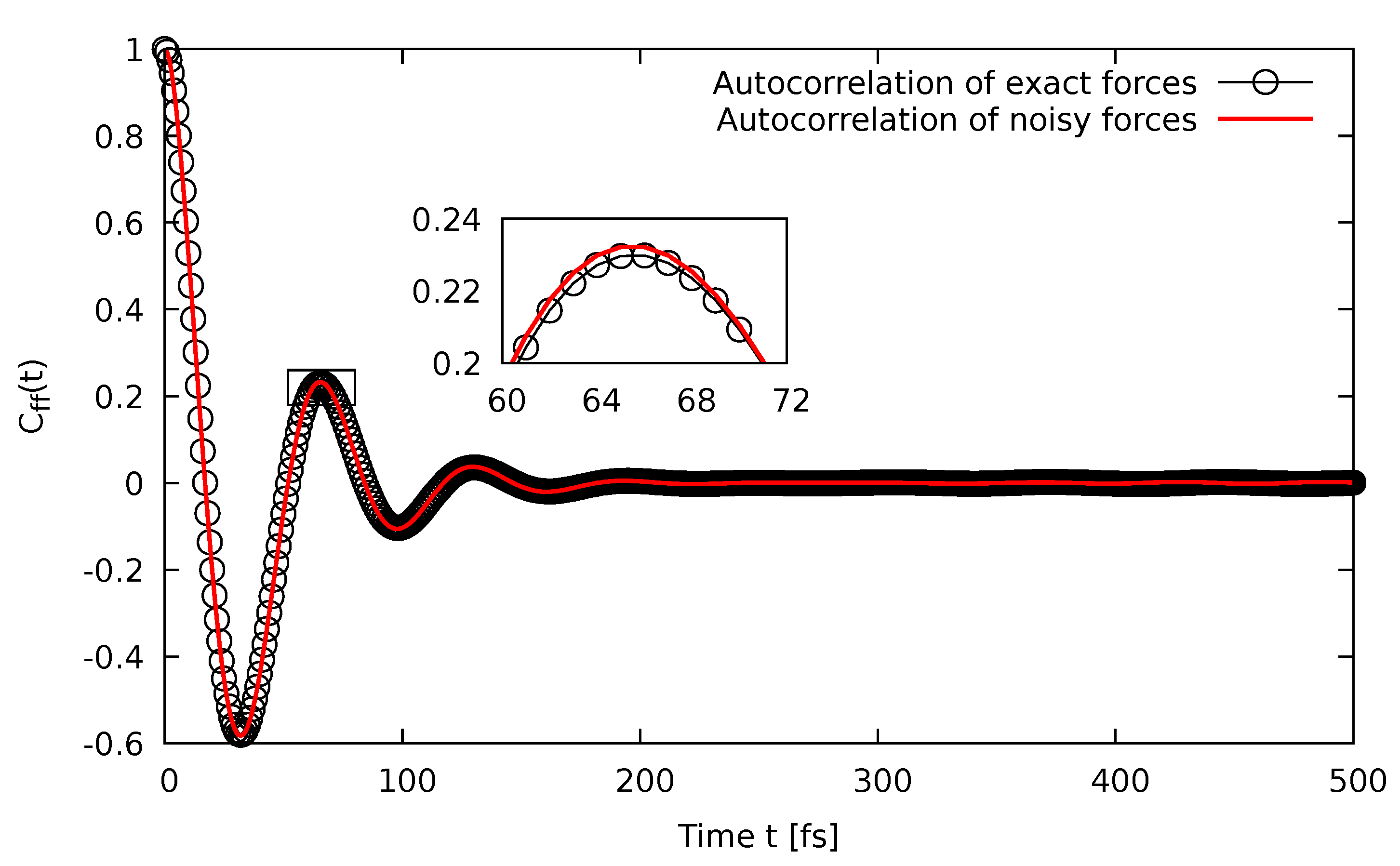Accurate Sampling with Noisy Forces from Approximate Computing
Abstract
1. Introduction
2. Approximate Computing
3. Methodology
4. Computational Details
5. Results and Discussion
6. Conclusions
Author Contributions
Funding
Conflicts of Interest
References
- Alder, B.J.; Wainwright, T.E. Phase Transition for a Hard Sphere System. J. Chem. Phys. 1957, 27, 1208–1209. [Google Scholar] [CrossRef]
- Rahman, A. Correlations in the Motion of Atoms in Liquid Argon. Phys. Rev. 1964, 136, A405–A411. [Google Scholar] [CrossRef]
- Car, R.; Parrinello, M. Unified approach for molecular dynamics and density-functional theory. Phys. Rev. Lett. 1985, 55, 2471–2474. [Google Scholar] [CrossRef] [PubMed]
- Kühne, T.D.; Krack, M.; Mohamed, F.R.; Parrinello, M. Efficient and accurate Car-Parrinello-like approach to Born-Oppenheimer molecular dynamics. Phys. Rev. Lett. 2007, 98, 066401. [Google Scholar] [CrossRef]
- Payne, M.C.; Teter, M.P.; Allan, D.C.; Arias, T.A.; Joannopoulos, J.D. Iterative minimization techniques for ab initio total-energy calculations: Molecular dynamics and conjugate gradients. Rev. Mod. Phys. 1992, 64, 1045–1097. [Google Scholar] [CrossRef]
- Kühne, T.D. Second generation Car–Parrinello molecular dynamics. WIREs Comput. Mol. Sci. 2014, 4, 391–406. [Google Scholar] [CrossRef]
- Tuckerman, M.E.; Berne, B.J.; Martyna, G.J. Reversible multiple time scale molecular dynamics. J. Chem. Phys. 1992, 97, 1990–2001. [Google Scholar] [CrossRef]
- Snir, M. A note on N-body computations with cutoffs. Theor. Comput. Syst. 2004, 37, 295–318. [Google Scholar] [CrossRef]
- Shan, Y.; Klepeis, J.L.; Eastwood, M.P.; Dror, R.O.; Shaw, D.E. Gaussian split Ewald: A fast Ewald mesh method for molecular simulation. J. Chem. Phys. 2005, 122, 054101. [Google Scholar] [CrossRef]
- Shaw, D.E. A fast, scalable method for the parallel evaluation of distance-limited pairwise particle interactions. J. Comput. Chem. 2005, 26, 1318–1328. [Google Scholar] [CrossRef]
- Gonnet, P. Pairwise Verlet Lists: Combining Cell Lists and Verlet Lists to Improve Memory Locality and Parallelism. J. Comput. Chem. 2012, 33, 76–81. [Google Scholar] [CrossRef] [PubMed]
- Gonnet, P. A quadratically convergent SHAKE in O(n(2)). J. Comput. Phys. 2007, 220, 740–750. [Google Scholar] [CrossRef]
- John, C.; Spura, T.; Habershon, S.; Kühne, T.D. Quantum ring-polymer contraction method: Including nuclear quantum effects at no additional computational cost in comparison to ab initio molecular dynamics. Phys. Rev. E 2016, 93, 043305. [Google Scholar] [CrossRef] [PubMed]
- Kühne, T.D.; Prodan, E. Disordered Crystals from First Principles I: Quantifying the Configuration Space. Ann. Phys. 2018, 391, 120–149. [Google Scholar] [CrossRef]
- Anderson, J.A.; Lorenz, C.D.; Travesset, A. General purpose molecular dynamics simulations fully implemented on graphics processing units. J. Comput. Phys. 2008, 227, 5342–5359. [Google Scholar] [CrossRef]
- Stone, J.E.; Hardy, D.J.; Ufimtsev, I.S.; Schulten, K. GPU-accelerated molecular modeling coming of age. J. Mol. Graph. Model. 2010, 29, 116–125. [Google Scholar] [CrossRef]
- Eastman, P.; Pande, V.S. OpenMM: A Hardware-Independent Framework for Molecular Simulations. Comput. Sci. Eng. 2010, 12, 34–39. [Google Scholar] [CrossRef]
- Colberg, P.H.; Höfling, F. Highly accelerated simulations of glassy dynamics using GPUs: Caveats on limited floating-point precision. Comput. Phys. Commun. 2011, 182, 1120–1129. [Google Scholar] [CrossRef]
- Brown, W.M.; Kohlmeyer, A.; Plimpton, S.J.; Tharrington, A.N. Implementing molecular dynamics on hybrid high performance computers – Particle–particle particle-mesh. Comput. Phys. Commun. 2012, 183, 449–459. [Google Scholar] [CrossRef]
- Le Grand, S.; Götz, A.W.; Walker, R.C. SPFP: Speed without compromise—A mixed precision model for GPU accelerated molecular dynamics simulations. Comput. Phys. Commun. 2013, 184, 374–380. [Google Scholar] [CrossRef]
- Abraham, A.J.; Murtola, T.; Schulz, R.; Pall, S.; Smith, J.C.; Hess, B.; Lindahl, E. GROMACS: High performance molecular simulations through multi-level parallelism from laptops to supercomputers. SoftwareX 2015, 1–2, 19–25. [Google Scholar] [CrossRef]
- Herbordt, M.C.; Gu, Y.; VanCourt, T.; Model, J.; Sukhwani, B.; Chiu, M. Computing Models for FPGA-Based Accelerators. Comput. Sci. Eng. 2008, 10, 35–45. [Google Scholar] [CrossRef] [PubMed]
- Herbordt, M.C.; Gu, Y.; VanCourt, T.; Model, J.; Sukhwani, B.; Chiu, M. Explicit design of FPGA-based coprocessors for short-range force computations in molecular dynamics simulations. Parallel Comput. 2008, 34, 261–277. [Google Scholar] [CrossRef]
- Shaw, D.E.; Deneroff, M.M.; Dror, R.O.; Kuskin, J.S.; Larson, R.H.; Salmon, J.K.; Young, C.; Batson, B.; Bowers, K.J.; Chao, J.C.; et al. Anton, a Special-purpose Machine for Molecular Dynamics Simulation. In Proceedings of the 34th Annual International Symposium on Computer Architecture, San Diego, CA, USA, 9–13 June 2007; ACM: New York, NY, USA, 2007; pp. 1–12. [Google Scholar] [CrossRef]
- Shaw, D.E.; Grossman, J.P.; Bank, J.A.; Batson, B.; Butts, J.A.; Chao, J.C.; Deneroff, M.M.; Dror, R.O.; Even, A.; Fenton, C.H.; et al. Anton 2: Raising the Bar for Performance and Programmability in a Special-purpose Molecular Dynamics Supercomputer. In Proceedings of the International Conference for High Performance Computing, Networking, Storage and Analysis, New Orleans, LA, USA, 16–21 November 2014; IEEE Press: Piscataway, NJ, USA, 2014; pp. 41–53. [Google Scholar] [CrossRef]
- Owens, J.D.; Houston, M.; Luebke, D.; Green, S.; Stone, J.E.; Phillips, J.C. GPU Computing. Proc. IEEE 2008, 96, 879–899. [Google Scholar] [CrossRef]
- Preis, T.; Virnau, P.; Paul, W.; Schneider, J.J. GPU accelerated Monte Carlo simulation of the 2D and 3D Ising model. J. Comput. Phys. 2009, 228, 4468–4477. [Google Scholar] [CrossRef]
- Weigel, M. Performance potential for simulating spin models on GPU. J. Comput. Phys. 2012, 231, 3064–3082. [Google Scholar] [CrossRef]
- Brown, F.R.; Christ, N.H. Parallel Supercomputers for Lattice Gauge Theory. Science 1988, 239, 1393–1400. [Google Scholar] [CrossRef]
- Boyle, P.A.; Chen, D.; Christ, N.H.; Clark, M.A.; Cohen, S.D.; Cristian, C.; Dong, Z.; Gara, A.; Joo, B.; Jung, C.; et al. Overview of the QCDSP and QCDOC computers. IBM J. Res. Dev. 2005, 49, 351–365. [Google Scholar] [CrossRef]
- Hut, P.; Makino, J. Astrophysics on the GRAPE Family of Special-Purpose Computers. Science 1999, 283, 501–505. [Google Scholar] [CrossRef]
- Fukushige, T.; Hut, P.; Makino, J. High-performance special-purpose computers in science. Comput. Sci. Eng. 1999, 1, 12–13. [Google Scholar] [CrossRef][Green Version]
- Belletti, F.; Cotallo, M.; Cruz, A.; Fernandez, L.A.; Gordillo-Guerrero, A.; Guidetti, M.; Maiorano, A.; Mantovani, F.; Marinari, E.; Martin-Mayor, V.; et al. Janus: An FPGA-Based System for High-Performance Scientific Computing. Comput. Sci. Eng. 2009, 11, 48. [Google Scholar] [CrossRef]
- Baity-Jesi, M.; Banos, R.A.; Cruz, A.; Fernandez, L.A.; Gil-Narvion, J.M.; Gordillo-Guerrero, A.; Iniguez, D.; Maiorano, A.; Mantovani, F.; Marinari, E.; et al. Janus II: A new generation application-driven computer for spin-system simulations. Comput. Phys. Commun. 2014, 185, 550–559. [Google Scholar] [CrossRef]
- Meyer, B.; Schumacher, J.; Plessl, C.; Forstner, J. Convey vector personalities—FPGA acceleration with an openmp-like programming effort? In Proceedings of the 22nd International Conference on Field Programmable Logic and Applications (FPL), Oslo, Norway, 29–31 August 2012; pp. 189–196. [Google Scholar] [CrossRef]
- Giefers, H.; Plessl, C.; Förstner, J. Accelerating Finite Difference Time Domain Simulations with Reconfigurable Dataflow Computers. SIGARCH Comput. Archit. News 2014, 41, 65–70. [Google Scholar] [CrossRef]
- Kenter, T.; Förstner, J.; Plessl, C. Flexible FPGA design for FDTD using OpenCL. In Proceedings of the 2017 27th International Conference on Field Programmable Logic and Applications (FPL), Ghent, Belgium, 4–8 September 2017. [Google Scholar] [CrossRef]
- Kenter, T.; Mahale, G.; Alhaddad, S.; Grynko, Y.; Schmitt, C.; Afzal, A.; Hannig, F.; Förstner, J.; Plessl, C. OpenCL-based FPGA Design to Accelerate the Nodal Discontinuous Galerkin Method for Unstructured Meshes. In Proceedings of the 2018 IEEE 26th Annual International Symposium on Field-Programmable Custom Computing Machines (FCCM), Boulder, CO, USA, 29 April–1 May 2018; Volume 1, pp. 189–196. [Google Scholar] [CrossRef]
- Klavík, P.; Malossi, A.C.I.; Bekas, C.; Curioni, A. Changing Computing Paradigms Towards Power Efficiency. Philos. Trans. R. Soc. A Math. Phys. Eng. Sci. 2014, 372. [Google Scholar] [CrossRef]
- Plessl, C.; Platzner, M.; Schreier, P.J. Approximate Computing. Inform. Spektrum 2015, 38, 396–399. [Google Scholar] [CrossRef]
- Lass, M.; Kühne, T.D.; Plessl, C. Using Approximate Computing for the Calculation of Inverse Matrix p-th Roots. IEEE Embed. Syst. Lett. 2018, 10, 33–36. [Google Scholar] [CrossRef]
- Angerer, C.M.; Polig, R.; Zegarac, D.; Giefers, H.; Hagleitner, C.; Bekas, C.; Curioni, A. A fast, hybrid, power-efficient high-precision solver for large linear systems based on low precision hardware. Sustain. Comput. Inform. Syst. 2016, 12, 72–82. [Google Scholar] [CrossRef]
- Haidar, A.; Wu, P.; Tomov, S.; Dongarra, J. Investigating half precision arithmetic to accelerate dense linear system solvers. In Proceedings of the 8th Workshop on Latest Advances in Scalable Algorithms for Large-Scale Systems, Denver, CO, USA, 13 November 2017. [Google Scholar] [CrossRef]
- Haidar, A.; Tomov, S.; Dongarra, J.; Higham, N.J. Harnessing GPU tensor cores for fast FP16 arithmetic to speed up mixed-precision iterative refinement solvers. In Proceedings of the International Conference for High Performance Computing, Networking, Storage, and Analysis, Dallas, TX, USA, 11–16 November 2018. [Google Scholar] [CrossRef]
- Gupta, S.; Agrawal, A.; Gopalakrishnan, K.; Narayanan, P. Deep learning with limited numerical precision. In Proceedings of the 32nd International Conference on International Conference on Machine Learning, Lille, France, 6–11 July 2015; pp. 1737–1746. [Google Scholar]
- NVIDIA Corporation. Tesla P100 Data Sheet; NVIDIA: Santa Clara, CA, USA, 2016. [Google Scholar]
- The Next Platform. Tearing Apart Google’s TPU 3.0 AI Coprocessor. Available online: https://www.nextplatform.com/2018/05/10/tearing-apart-googles-tpu-3-0-ai-coprocessor/ (accessed on 27 April 2020).
- Top 500. Intel Lays Out New Roadmap for AI Portfolio. Available online: https://www.top500.org/news/intel-lays-out-new-roadmap-for-ai-portfolio/ (accessed on 27 April 2020).
- Strzodka, R.; Goddeke, D. Pipelined Mixed Precision Algorithms on FPGAs for Fast and Accurate PDE Solvers from Low Precision Components. In Proceedings of the 14th Annual IEEE Symposium on Field-Programmable Custom Computing Machines, Napa, CA, USA, 24–26 April 2006. [Google Scholar] [CrossRef]
- Kenter, T.; Vaz, G.; Plessl, C. Partitioning and Vectorizing Binary Applications. In Lecture Notes in Computer Science, Proceedings of the International Conference on Reconfigurable Computing: Architectures, Tools and Applications (ARC), Vilamoura, Portugal, 14–16 April 2014; Springer: Berlin/Heidelberg, Germany, 2014; Volume 8405, pp. 144–155. [Google Scholar] [CrossRef]
- Kenter, T.; Schmitz, H.; Plessl, C. Pragma based parallelization—Trading hardware efficiency for ease of use? In Proceedings of the 2012 International Conference on Reconfigurable Computing and FPGAs, Cancun, Mexico, 5–7 December 2012. [CrossRef]
- Microprocessor Standards Committee of the IEEE Computer Society. IEEE Std. 754-2019—IEEE Standard for Floating-Point Arithmetic; IEEE: Toulouse, France, 2019. [Google Scholar]
- Krajewski, F.R.; Parrinello, M. Linear scaling electronic structure calculations and accurate statistical mechanics sampling with noisy forces. Phys. Rev. B 2006, 73, 041105. [Google Scholar] [CrossRef]
- Richters, D.; Kühne, T.D. Self-consistent field theory based molecular dynamics with linear system-size scaling. J. Chem. Phys. 2014, 140, 134109. [Google Scholar] [CrossRef]
- Karhan, K.; Khaliullin, R.Z.; Kühne, T.D. On the role of interfacial hydrogen bonds in “on-water” catalysis. J. Chem. Phys. 2014, 141, 22D528. [Google Scholar] [CrossRef]
- Hutter, J.; Iannuzzi, M.; Schiffmann, F.; VandeVondele, J. CP2K: Atomistic simulations of condensed matter systems. WIREs Comput. Mol. Sci. 2014, 4, 15–25. [Google Scholar] [CrossRef]
- Kühne, T.; Iannuzzi, M.; Del Ben, M.; Rybkin, V.; Seewald, P.; Stein, F.; Laino, T.; Khaliullin, R.; Schütt, O.; Schiffmann, F.; et al. CP2K: An Electronic Structure and Molecular Dynamics Software Package—Quickstep: Efficient and Accurate Electronic Structure Calculations. arXiv 2020, arXiv:physics.chem-ph/2003.03868. [Google Scholar]
- Bazant, M.Z.; Kaxiras, E. Modeling of Covalent Bonding in Solids by Inversion of Cohesive Energy Curves. Phys. Rev. Lett. 1996, 77, 4370–4373. [Google Scholar] [CrossRef] [PubMed]
- Bazant, M.Z.; Kaxiras, E.; Justo, J.F. Environment-dependent interatomic potential for bulk silicon. Phys. Rev. B 1997, 56, 8542–8552. [Google Scholar] [CrossRef]
- Ricci, A.; Ciccotti, G. Algorithms for Brownian dynamics. Mol. Phys. 2003, 101, 1927–1931. [Google Scholar] [CrossRef]
- Jones, A.; Leimkuhler, B. Adaptive stochastic methods for sampling driven molecular systems. J. Chem. Phys. 2011, 135, 084125. [Google Scholar] [CrossRef]
- Mones, L.; Jones, A.; Goötz, A.W.; Laino, T.; Walker, R.C.; Leimkuhler, B.; Csanyi, G.; Bernstein, N. The Adaptive Buffered Force QM/MM Method in the CP2K and AMBER Software Packages. J. Comput. Chem. 2015, 36, 633–648. [Google Scholar] [CrossRef]
- Leimkuhler, B.; Sachs, M.; Stoltz, G. Hypocoercivity Properties Of Adaptive Langevin Dynamics. arXiv 2019, arXiv:math.PR/1908.09363. [Google Scholar]
- Nosé, S. A unified formulation of the constant temperature molecular dynamics methods. J. Chem. Phys. 1984, 81, 511. [Google Scholar] [CrossRef]
- Hoover, W.G. Canonical dynamics: Equilibrium phase-space distributions. Phys. Rev. A 1985, 31, 1695–1697. [Google Scholar] [CrossRef]
- Scheiber, H.; Shi, Y.; Khaliullin, R.Z. Communication: Compact orbitals enable low cost linear-scaling ab initio molecular dynamics for weakly-interacting systems. J. Chem. Phys. 2018, 148, 231103. [Google Scholar] [CrossRef] [PubMed]
- Röhrig, K.A.F.; Kühne, T.D. Optimal calculation of the pair correlation function for an orthorhombic system. Phys. Rev. E 2013, 87, 045301. [Google Scholar] [CrossRef] [PubMed]
- Kapil, V.; Rossi, M.; Marsalek, O.; Petraglia, R.; Litman, Y.; Spura, T.; Cheng, B.; Cuzzocrea, A.; Meißner, R.H.; Wilkins, D.M.; et al. i-PI 2.0: A universal force engine for advanced molecular simulations. Comput. Phys. Commun. 2019, 236, 214–223. [Google Scholar] [CrossRef]
- Steane, A.M. Efficient fault-tolerant quantum computing. Nature 1999, 399, 124–126. [Google Scholar] [CrossRef]
- Knill, E. Quantum computing with realistically noisy devices. Nature 2005, 434, 39–44. [Google Scholar] [CrossRef]
- Benhelm, J.; Kirchmair, G.; Roos, C.F.; Blatt, R. Towards fault-tolerant quantum computing with trapped ions. Nat. Phys. 2008, 4, 463–466. [Google Scholar] [CrossRef]
- Chow, J.M.; Gambetta, J.M.; Magesan, E.; Abraham, D.W.; Cross, A.W.; Johnson, B.R.; Masluk, N.A.; Ryan, C.A.; Smolin, J.A.; Srinivasan, S.J.; et al. Implementing a strand of a scalable fault-tolerant quantum computing fabric. Nat. Commun. 2014, 5, 4015. [Google Scholar] [CrossRef]
- Efstathiou, G.; Davis, M.; Frenk, C.S.; White, S.D.M. Numerical techniques for large cosmological N-body simulations. Astrophys. J. 1985, 57, 241–260. [Google Scholar] [CrossRef]
- Hernquist, L.; Hut, P.; Makino, J. Discreteness Noise versus Force Errors in N-Body Simulations. Astrophys. J. 1993, 402, L85. [Google Scholar] [CrossRef]
- Lass, M.; Mohr, S.; Wiebeler, H.; Kühne, T.D.; Plessl, C. A Massively Parallel Algorithm for the Approximate Calculation of Inverse P-th Roots of Large Sparse Matrices. In Proceedings of the Platform for Advanced Scientific Computing Conference, Basel, Switzerland, 2–4 July 2018; ACM: New York, NY, USA, 2018; pp. 7:1–7:11. [Google Scholar] [CrossRef]




| Type | Sign | Exponent | Mantissa |
|---|---|---|---|
| IEEE 754 quadruple-precision | 1 | 15 | 112 |
| IEEE 754 double-precision | 1 | 11 | 52 |
| IEEE 754 single-precision | 1 | 8 | 23 |
| IEEE 754 half-precision | 1 | 5 | 10 |
| Bfloat16(truncated IEEE single-precision) | 1 | 8 | 7 |
| 0 | 0.00025 | |
| 1 | 0.0004 | 0.000005 |
| 2 | 0.000009 | 0.000005 |
| 3 | 0.0000009 |
© 2020 by the authors. Licensee MDPI, Basel, Switzerland. This article is an open access article distributed under the terms and conditions of the Creative Commons Attribution (CC BY) license (http://creativecommons.org/licenses/by/4.0/).
Share and Cite
Rengaraj, V.; Lass, M.; Plessl, C.; Kühne, T.D. Accurate Sampling with Noisy Forces from Approximate Computing. Computation 2020, 8, 39. https://doi.org/10.3390/computation8020039
Rengaraj V, Lass M, Plessl C, Kühne TD. Accurate Sampling with Noisy Forces from Approximate Computing. Computation. 2020; 8(2):39. https://doi.org/10.3390/computation8020039
Chicago/Turabian StyleRengaraj, Varadarajan, Michael Lass, Christian Plessl, and Thomas D. Kühne. 2020. "Accurate Sampling with Noisy Forces from Approximate Computing" Computation 8, no. 2: 39. https://doi.org/10.3390/computation8020039
APA StyleRengaraj, V., Lass, M., Plessl, C., & Kühne, T. D. (2020). Accurate Sampling with Noisy Forces from Approximate Computing. Computation, 8(2), 39. https://doi.org/10.3390/computation8020039






